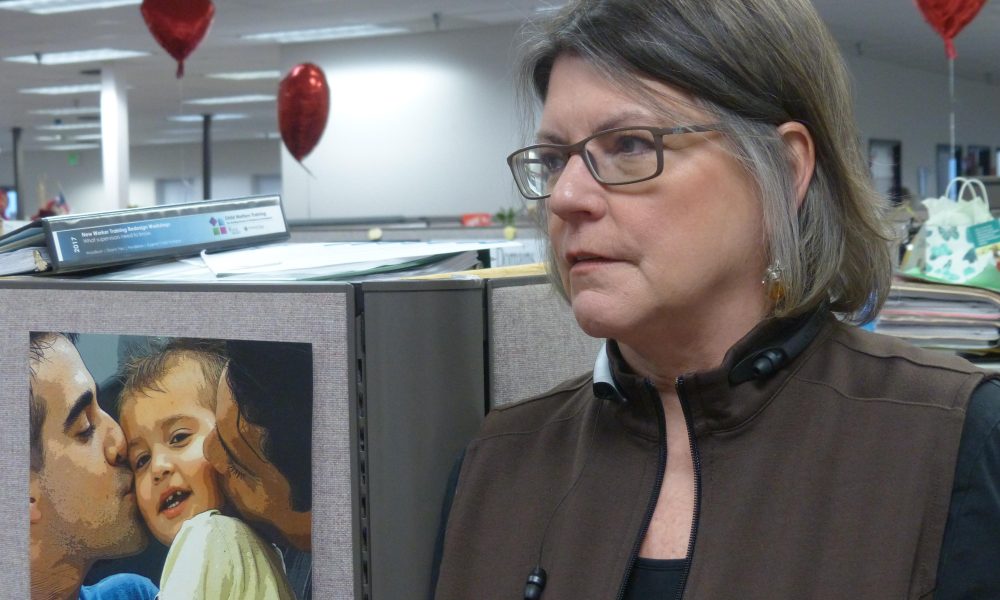
Wendy Hill, district director in Ontario for the state Department of Human Services, has faced a growing number of foster children in state care but a shortage of caseworkers and foster parents. (The Enterprise/Les Zaitz)
ONTARIO – The two sisters, so neglected that they had been removed from their home, spent days around Christmas in a motel room, tended to by state workers instead of parents.
There was no other choice for the girls, 13 and 8.
They couldn’t be left with parents who couldn’t or wouldn’t tend their needs.
They couldn’t go to a temporary home under the care of foster parents. None were available.
And they couldn’t sleep in the offices of the state Department of Human Services, although children in the past have spent their days during office hours in the government building.
The sisters were caught up in a system that is blinking red in Malheur County.
The foster care network is overwhelmed, stressed by a surge in children who can no longer be left safely at home, according to a lengthy investigation by the Malheur Enterprise.
Statewide, officials are bracing for even more kids, for spring traditionally sees a wave of abuse reports and police investigations that take children from their homes.
The system in Malheur County and across Oregon doesn’t have enough of anything but children.
The Enterprise’s investigation found:
• There are not enough caseworkers – those front-line state employees with duty to tend to the children. The Ontario office has been chronically understaffed. Turnover is high. And training new workers takes months.
• There are not enough foster homes. Until recently, the state hadn’t changed the reimbursement for caring for foster children in years. Some adults shy from volunteering, worried about liability or fearing accusations by those they accept into their home.
At the moment, Malheur County has 24 general foster homes. Officials say they need 50 more.
• There are not enough volunteers whose sole duty is to speak for the children, known as CASAs. That refers to court-appointed special advocates, trained adults who ensure kids don’t just become a name and a file in the state system.
At the moment, Malheur County has seven CASAs. At least 20 more are needed.
• There are not enough specialized foster homes for children with profound medical and mental health needs. The one local organization specializing in treating such children was asked 13 times last year to provide for yet another child. Only three times could it say yes.
Scandals elsewhere involving abusive parents or neglectful caseworkers haven’t helped, generating headlines across Oregon that deter people from volunteering.
“Nobody wants to be on a losing team,” said Kevin George, state program manager for foster care within the giant human services agency.
“You’d have to be blind not to have concerns about the foster care system in this state,” said state Sen. Elizabeth Steiner Hayward, D-Portland, who sits on the Legislature’s budget committee and was once a foster parent.
At a community meeting in Ontario last year, advocates implored people to help the county’s most vulnerable kids.
“They are the hidden children,” said one.
Violence at home
Not long ago, state workers encountered a 10-year-old boy with a black eye. They asked the boy what happened.
His mother, he said, had smacked him across the face that morning and punched him until he was bleeding. He said this happens often. Once, he said, she hit him in the back with a bat.
The boy was taken into state custody.
In another home, a child described her stepfather strangling her mother and other incidents of violence. The parents sometimes left the children home alone, locked in and unable to get out.
The children were taken into state custody.
Time after time in Malheur County, state officials take custody of children when they are starving, physically abused, or otherwise neglected at home.
The strain to protect children in Malheur County is growing.
In recent years, the state child welfare program managed at any time about 130 children placed in foster homes in the county. In 2017, the number climbed month by month. By year’s end, 179 children were in state care.
Even with 130 children, “the system was being overwhelmed,” said Louise Schneider, who retired last year from the Ontario state office.
“It’s an epidemic here,” said Sylvia Medina, a Vale area foster parent.
“We don’t have the capacity to serve them,” said Wendy Hill, district director in Ontario for the state Human Services Department.
The system statewide struggles to care for foster children. The risks of not acting to protect a child are high.
In 2016, according to state figures, 19 children died from abuse or neglect in Oregon. Fourteen died at the hands of a parent.
The state responded to 15,354 complaints that year about suspected abuse. The state immediately removed one out of every four children as investigators discovered threatening conditions.

Workers at the state Department of Human Services monitor a mother’s visit with her children recently at the Ontario office. The workers watch through one-way glass to help judge when children in foster care can safely be returned home. The family visiting rooms have toys and aging furniture. Children arriving for these visits enter through stark hallways from a government parking lot. (The Enterprise/Les Zaitz)
In Malheur County, state workers find methamphetamine at the root of many cases. Drug-using parents don’t feed their children, leave them unattended, and live in squalor.
Officials said the most common scenario is a mother with children living with a boyfriend. The children’s father may not be known, or can’t be found – or wants nothing to do with children. The mothers themselves often are abused.
Such a lifestyle can mean a perilous start for children who are born drug-addicted. Those children endure crippling withdrawal, and often are taken from their mother’s custody within days of birth.
Gary Kiyuna, a Nyssa attorney frequently appointed to represent foster children, has seen such babies too often.
“They squeal. They clutch. They draw up their feet,” Kiyuna said. “They don’t sound like a baby.”
Older children often are forced to become the parent, tending to siblings because the mom or dad or both are incapacitated by drugs –or gone from the home altogether, sometimes for days.
When state workers respond to reports of abuse and neglect, they have three choices. They can conclude the children are safe and close the case, arrange help for parents to raise their children under the watchful eye of the state, or take the children because the risks are too high to leave them in the home another moment.
“Every kid who goes into foster care represents a tragedy,” said Patricia Sullivan, Malheur County senior circuit judge.
A state task force in 2016 found that children put into foster care “are more likely to be homeless, un- or under-employed, enmeshed in the delinquency and criminal justice systems, and more likely to suffer long-term physical and mental health needs.”
When children must be removed from parents, the state’s immediate focus is on one task: Find them a new, safe place to live.
The first choice is a willing – and qualified – relative, usually a grandparent or an aunt. Sometimes, state workers ask another adult who knows the children to step in. Teachers are favored in some circumstances to act as emergency parents.
Sullivan recalled a 16-year-old boy in state care because his mom had disappeared and his father was in Mexico. State workers knew he was close to his high school math teacher, and asked her to serve as his foster parent.
“We put the pressure on her, and she did,” Sullivan said.
If that doesn’t work, state workers turn to their list of foster parents. They start with those they know are certified and have room for children. Sometimes, it means asking foster parents to take on more children than they initially agreed. Sometimes it means asking those who dropped out of the system to return, even if for a short time.
“I know a lady who called just to inquire about being a foster parent,” said Monica Grenz, a longtime foster parent. “Two days later, she had kids in her home. My jaw just dropped.”
Grenz said that just before Thanksgiving, state officials called to ask if she could take a teenage girl, her infant son, and the teenager’s 13-year-old sister. She said she had to say no. She already had eight children in her home. She never heard what became of the children.
The need is so pressing, that state workers scour the community for places to put a child or a group of children.
“Some of our foster parents, they don’t answer the phone if they know we’re calling,” said Christine Phillips, manager of the state child welfare program in Ontario.
Circuit Court Judge Lung Hung, the presiding judge in Malheur County, is passionate about the foster care system and the challenge of finding a new home for children.
“Sometimes they have to go in homes that are not prepared for their needs,” said Hung.
For caseworkers, there is little choice.
If a local home can’t be found, caseworkers start calling colleagues in neighboring counties. When that doesn’t work, they resort to a statewide alert. Sometimes, siblings must be split up and sent to different homes just to get them into a safe place to sleep.
All of that can take days. Meantime, the children have to go somewhere. Under no circumstance are they allowed to go home with their state rescuers.
In Malheur County, one answer has been to put up children in local motels. It’s an expensive option. At least two state workers must take shifts through the night to watch over the children. The children get one room, the workers another.
Last year, one foster child was housed in an Ontario motel for 50 days. In another case, the stay lasted three weeks.
During the day, children may end up spending time at the Ontario state office.
“They’re running through the office and we’re running after them,” said Schneider, the retired state worker.
Finding a home is just the first challenge. State workers then have to mobilize to make sure kids get to school, get medical, dental or mental health care, are shuttled to appointments, and get counseling they need.
That work falls to overworked employees.
State records show the Ontario office should have at last 25 caseworkers to adequately serve the number of children in state care. At the moment, it has 19.
“We’re asking too much of the caseworkers,” said George, the state program manager. The demands seem to grow, he said. The state at the beginning of the year added 10 new policies, paperwork that caseworkers were expected to study and obey while still carrying heavy caseloads.
In Ontario, caseworkers are handling up to 25 cases at a time, “a tremendous amount,” according to Hill.
That is more than double what the state calculates they should carry.
Drowning in paperwork
Andrea Lockner left the Ontario agency because “I was drowning” in paperwork and duties. She now works with a local nonprofit caring for needy children.
Jaime Grimaldo joined the state agency in 2008 and became a caseworker the following year.
“My first day, I was handed a caseload of 21. Another caseworker had left,” said Grimaldo, who is moving into a lead worker role. One case can involve several children.
A caseworker has to get up to speed on each child in a hurry, he said. The worker needs to learn why children were removed, where they go to school, what their parents need, whether there are relatives are in the area, and what court appearances or medical appointments loom.
Case files grow thicker and thicker. Reports are the life of a caseworker – reports to the master file, reports to supervisors, time-sensitive reports to the court. A missing report can disrupt care for a child or delay efforts to return a child to the parents.
“There’s never a feeling of being caught up,” said Grimaldo. “There’s always one more call to return. There’s one more case note to make.”
Melissa Jacobs grew up on a Vale dairy ranch and was a drug-and-alcohol counselor before she joined the state. She was surprised by the heavy workload and how complex each case can be.
“If it’s not documented, it didn’t happen,” said Jacobs, who also serves on the Vale City Council.
Schneider said the crisis atmosphere keeps caseworkers from spending as much time as they should with foster children and their parents.
“The demand of the job is to get reports out,” said Schneider.
Caseworkers simply can’t keep up.
David Brewer, retired justice of the Oregon Supreme Court, has long had an interest in foster care issues.
He said the shortage in staffing ripples through the system, even affecting the judges, who must decide when a child must remain in state care, what parents must do to recover their children, and comply with state laws mandating regular reviews in court of each child’s status.
Judges sometimes don’t have a full sense of what has happened to a child because of the “number of missing, out-of-date or confusing documents,” Brewer said.
He said caseworkers usually appear in court by themselves, with no state attorney to help. The front-line workers must go up against as many as three attorneys, one for each parent and one for the child. This, he said in his speech, creates a “significant risk” that caseworkers engage in what he called the “unlawful practice of law.”
“I’ve seen hearings where it turns into a free-for-all,” Brewer said in an interview. “They blame the caseworker.”
The result is children can stay in the foster system longer than they should.
“There are too many hearings in too short a time and not enough people to do the work,” he said.
Jacobs said that besides helping children, caseworkers also have to help parents.
Most foster cases are opened with one premise: the child will be going back home.
But that only happens if parents change the conduct that led the state to take their children in the first place. That can mean drug treatment. Or a move into decent housing. Or getting a job and dumping an abusive lover.
Caseworkers also are expected to regularly see foster children, even when they are placed in a foster home. And they must arrange for parents to visit their children, usually in closely supervised moments in a stark room at the Ontario state office.
“You’re assessing safety – always,” Jacobs said.
She said parents retain rights over their children. They must, for instance, approve a haircut for a child who is living with foster parents.
“Nothing is simple,” she said. “You have to have a passion for this job or you won’t make it.”
State legislators last year agreed to spend an additional $12 million in the current budget to expand the child welfare workforce. That includes money for 50 new jobs – scattered across 47 state offices.
In Ontario, officials hope to boost their training staff to three. They have one now. They hope to get more caseworkers as well.
“The decision was made to increase staffing first because we knew that without cutting our caseload, we’d never be able to support foster parents,” Steiner said.
But gaining ground isn’t easy. In October, the state hired 18 new caseworkers while 14 others quit.
Audit calls for change
Pressure is building to do better.
Dennis Richardson, Oregon secretary of state, in January jabbed a white hot political poker into the system, criticizing foster care from start to finish.
His recent audit found that the state child welfare system is “disorganized, inconsistent, and high risk for the children it serves” and “struggles to retain and support foster homes.”
His auditors documented “chronic understaffing, overwhelming workloads, high turnover, and a large proportion of inexperienced staff.”
The 59-page report recommended changes throughout the system, listing 24 specific steps the state should take to better care for children
Public officials expressed outrage and promised action.
Gov. Kate Brown said she was requiring her agency officials to report directly to her every month on what’s getting fixed. Last week, she asked legislators for $14 million to hire more caseworkers.
State Rep. Knute Buehler, a Republican from Bend running for governor, demanded state legislators put another $50 million into the foster care system.
Brewer said he will continue pressing for reforms in the legal system to see that kids are better served. He said Oregon needs a system “where it’s less about the bureaucracy, less about paper and moving cases and more about the system more about problem solving.”
Until reforms take hold, said Hayward, “We’re not going to be doing our jobs to protect Oregon’s most vulnerable children.”
In Malheur County, state officials and advocates for children aren’t waiting for help from Salem.
For instance, they have scheduled a public summit in April to recruit hard for more foster parents.
Child advocates in government, at law firms, and in local charities say the solutions won’t all be found in government offices.
Citizens can and should help, even if they don’t become foster parents, they said.
“The foster care system is not a solution,” said Hung. “It’s a stopgap.”
Contact Les Zaitz: [email protected] or 541-473-3377.




